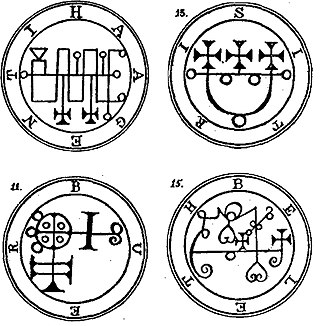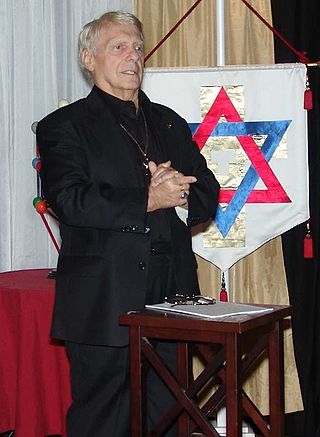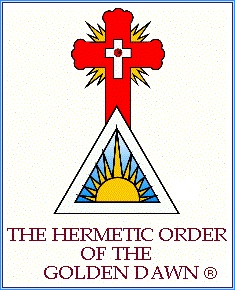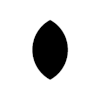Earth is one of the classical elements, in some systems being one of the four along with air, fire, and water.

The Hermetic Order of the Golden Dawn, more commonly the Golden Dawn, was a secret society devoted to the study and practice of occult Hermeticism and metaphysics during the late 19th and early 20th centuries. Known as a magical order, the Hermetic Order of the Golden Dawn was active in Great Britain and focused its practices on theurgy and spiritual development. Many present-day concepts of ritual and magic that are at the centre of contemporary traditions, such as Wicca and Thelema, were inspired by the Golden Dawn, which became one of the largest single influences on 20th-century Western occultism.
A pentacle is a talisman that is used in magical evocation, and is usually made of parchment, paper, cloth, or metal, upon which a magical design is drawn. Symbols may also be included, a common one being the six-point form of the Seal of Solomon.

Francis Israel Regardie was a British-American occultist, ceremonial magician, and writer who spent much of his life in the United States. He wrote fifteen books on the subject of occultism.

A sigil is a type of symbol used in magic. The term has usually referred to a pictorial signature of a deity or spirit. In modern usage, especially in the context of chaos magic, sigil refers to a symbolic representation of the practitioner's desired outcome.
According to various Indian schools of philosophy, tattvas are the elements or aspects of reality that constitute human experience. In some traditions, they are conceived as an aspect of deity. Although the number of tattvas varies depending on the philosophical school, together they are thought to form the basis of all our experience. The Samkhya philosophy uses a system of 25 tattvas, while Shaivism recognises 36 tattvas. In Buddhism, the equivalent is the list of dhammas which constitute reality, as in Nama-rupa.

A lamen is a magical pendant or breastplate worn around the neck so that it hangs upon the breast over the heart. Its uses vary but, most commonly, the term refers to a symbol of authority and a focus of magical energies. Aleister Crowley described the lamen as "a sort of coat of arms. It expresses the character and powers of the wearer." Crowley and DuQuette have proposed that the magical lamen might be a modern adaptation of the priestly breastplate of the ancient Hebrews.
Sathariel is described in the Book of Enoch as the 17th Watcher of the 20 leaders of the 200 fallen angels. Michael Knibb believes the name to mean "Moon of God" or "Dawn of God" based on the Ge'ez copies of the Book of Enoch.

The Mathers table of Hebrew and "Chaldee" (Aramaic) letters is a tabular display of the pronunciation, appearance, numerical values, transliteration, names, and symbolism of the twenty-two letters of the Hebrew alphabet appearing in The Kabbalah Unveiled, S.L. MacGregor Mathers' late 19th century English translation of Kabbala Denudata, itself a Latin translation by Christian Knorr von Rosenroth of the Zohar, a primary Kabbalistic text.
The Cipher Manuscripts are a collection of 60 folios containing the structural outline of a series of magical initiation rituals corresponding to the spiritual elements of Earth, Air, Water and Fire. The "occult" materials in the Manuscripts are a compendium of the classical magical theory and symbolism known in the Western world up until the middle of the 19th century, combined to create an encompassing model of the Western mystery tradition, and arranged into a syllabus of a graded course of instruction in magical symbolism. It was used as the structure for the Hermetic Order of the Golden Dawn.

Enochian chess is a four-player chess variant, similar to chaturaji, associated with the Hermetic Order of the Golden Dawn. The name comes from the Enochian system of magic of Dr. John Dee, which was later adapted by Victorian members of the Golden Dawn into "a complete system of training and initiation".
In ceremonial magic, banishing refers to one or more rituals intended to remove non-physical influences ranging from spirits to negative influences. Although banishing rituals are often used as components of more complex ceremonies, they can also be performed by themselves. Banishing can be viewed as one of several techniques of magic, closely related to ritual purification and a typical prerequisite for consecration and invocation.

The Lesser Ritual of the Pentagram is a ceremonial magic ritual devised and used by the original order of the Golden Dawn that has become a mainstay in modern occultism. This ritual is considered by many to be a basic preliminary to any other magical work, so much that it was the only ritual, besides initiation rituals, taught to members of the Golden Dawn before they advanced to the Inner Order.
The Stella Matutina was an initiatory magical order dedicated to the dissemination of the traditional occult teachings of the earlier Hermetic Order of the Golden Dawn. Originally, the outer order of the Stella Matutina was known as Mystic Rose or Order of the M.R. in the Outer. When occult writer Israel Regardie released documents of the Golden Dawn to the public it was the teachings of the Stella Matutina that he revealed, not those of the original order. The Stella Matutina was one of several daughter organisations into which the Hermetic Order of the Golden Dawn fragmented, including the Alpha et Omega led by John William Brodie-Innes and Macgregor Mathers, the Isis-Urania Temple led by A.E. Waite, and others.

The Alpha et Omega was an occult order, initially named the Hermetic Order of the Golden Dawn, co-founded in London, England by Samuel Liddell MacGregor Mathers in 1888. The Alpha et Omega was one of four daughter organisations into which the Hermetic Order of the Golden Dawn fragmented, the others being the Stella Matutina; the Isis-Urania Temple led by A. E. Waite and others; and Aleister Crowley's A∴A∴. Following a rebellion of adepts in London and an ensuing public scandal which brought the name of the Golden Dawn into disrepute, Mathers renamed the branch of the Golden Dawn remaining loyal to his leadership to "Alpha et Omega" sometime between 1903 and 1913. "The title was usually abbreviated as A.O." and according to some sources its full name was "Rosicrucian Order of Alpha et Omega". All of the temples of the order appear to have gone out of existence by the Second World War.
Magical mottoes are the magical nicknames, pen names, or pseudonyms taken by individuals in a number of magical organizations. These members were known and sometimes referred to in many publications by these mottoes. Members of these organizations typically adopted such a motto at their initiation into the neophyte grade of the organizations.

Charles "Chic" Cicero is an American esoteric writer. He was born in Buffalo, New York. He has been a practicing ceremonial magician for the past forty years.
Sandra Tabatha Cicero is an American esoteric writer and lecturer, best known for her work in the field of Hermeticism.

Hermetic Qabalah is a Western esoteric tradition involving mysticism and the occult. It is the underlying philosophy and framework for magical societies such as the Golden Dawn, Thelemic orders, mystical-religious societies such as the Builders of the Adytum and the Fellowship of the Rosy Cross, and is a precursor to the Neopagan, Wiccan and New Age movements. The Hermetic Qabalah is the basis for Qliphothic Qabala as studied by left-hand path orders, such as the Typhonian Order.

The Hermetic Order of the Golden Dawn, Inc. is a 501(c) non-profit organization associated with a modern magical Order of the same name. While bearing the same name as the historical Hermetic Order of the Golden Dawn (1888–1908), the modern Order does not have direct descent or institutional lineage from the original Order. According to author Gerald Suster, this Order is notable for having the only working Golden Dawn temple in the United States at the end of the 1970s, making it the oldest continuously operating Golden Dawn offshoot in the U.S.


















